1 |
Antennae gradually or abruptly clubbed, the tip sometimes hooked; hindwing without
frenulum and with enlarged humeral area (Fig.. 2), often with humeral vein
present ............................................................................. PAPILIONOIDEA (the butterflies)
|
|
- |
Antennae filiform or tapered, often ciliate, pectinate or plumose; if dilated
or clubbed, a frenulum is present on the hindwing (e.g. Fig. 1) (N.B. Euschemon,
an Australian hesperiid butterfly, has a frenulum; the CALLIDULIDAE
have filiform antennae that broaden very slightly and evenly towards the apex
and lack a frenulum in many cases)............................................................... 2 |
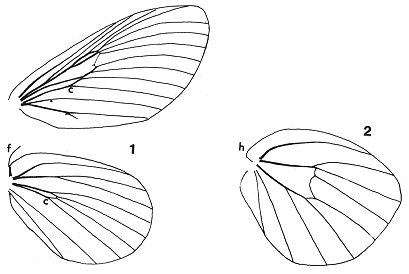
Figures 1-2. 1, Venation of Tephrostola gramivora, a New World
castniid, showing the frenulum (f) and narrow cell (c) with the quadrifid
condition: four veins arising from it. 2, Venation of hindwing of Eurema
hecabe (Pieridae) showing absence of frenulum and an enlarged humeral area
(h).
|
2 |
Wings usually cleft into two or more plumes �....�.......................................................��..
3 |
|
- |
Wings entire, sometimes vestigial
����.��..............................................................�...
4 |
|
|
| 3 |
Wings cleft into 2-4 plumes �....................................���
Pterophoridae (microlepidoptera) |
|
- |
Wings cleft into 6 or 7 plumes ���......................................�.
Alucitidae (microlepidoptera) |
|
|
| 4 |
Wings fully developed �����.....��..........................................................�����
5 |
|
- |
Wings not fully developed (♀♀)
���................�����........................................�
54 |
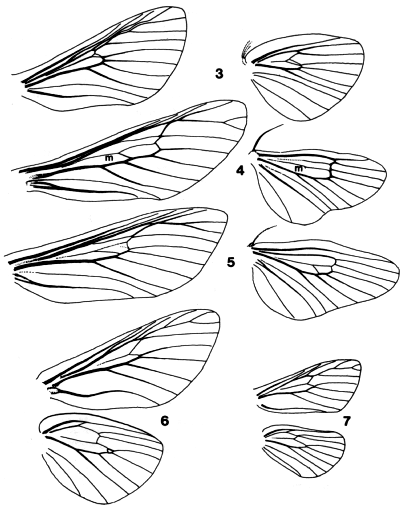
Figures
3-7.
Venation of Cossidae (3-5) and Metarbeidae (6, 7), showing the presence
of the M vein stem (m) in the cell. 3, Cossus chloratus; 4, Zeuzera
lineata; 5, Xyleutes lutescens;
6, Squamura kinabalua;
7, S. disciplaga.
| 5 |
Antennae smooth, broadly clubbed; mostly robust moths; chaetosemata (Fig.
8) absent and hindwing not tailed (presence of these last two characters in
absence of venation character below - SEMATURIDAE (part)); distinctive
quadrifid arrangement of veins arising from narrow cell formed from M and Cu on
both wings (Fig. 1) .................................................... CASTNIIDAE
|
| - |
Antennae not distinctly clubbed, sometimes dilated, often ciliate or
pectinate; venation not as
above.....................................................................................................................................
6 |
|
|
| 6 |
Vein M moderately to strongly present in cells of both wings (Figs.
3-7) ��� COSSOIDEA, ZYGAENOIDEA, some Tineoidea ����.����������..................................
7 |
|
- |
Vein M weak or absent in cells of one or both wings (e.g. Fig. 26)
��...................................
21 |
|
|
|
7
|
Chaetosemata (Fig. 8) present
�����������������................................
8
|
|
-
|
Chaetosemata
absent��������������������.�.............................
10
|
|
|
|
8
|
Ocelli absent; venation as in first couplet of 19 (Fig. 11); Neotropics only
.............................................................................................
MEGALOPYGIDAE (part)
|
|
-
|
Ocelli present (e.g. Fig. 8), or not; Neotropics
������������............................ 9
|

Figure 8. Dorsal view of the head of a chalcosiine zygaenid, showing the
chaetosema (c) and ocellus (o). The chaetosema (plural: chaetosemata) here
covers a broad area posterior to the ocellus, the bristles arising from a
�honeycomb' of short, broad scales. In other families, e.g. Tortricidae, the
chaetosema is restricted to a small tuft of bristles just posterior to the
ocellus.
|
9
|
Haustellum (coiled tongue) present; antennae often thickened; forewing radial
veins often branched; usually brightly coloured.
..................................................................
ZYGAENIDAE
|
| -
|
Haustellum absent; antennae bipectinate; forewing radial veins arise
directly from cell; small, sparsely scaled brownish species; W. Europe,
S. Africa �.�.................. HETEROGYNIDAE
|
|
|
| 10
|
Tympanum present at base of abdomen (sternites 1 + 2) �....���.......�DUDGEONEIDAE
|
|
-
|
Tympanum absent
������������������������������11
|
|
|
|
11
|
Forewing with only one strong anal vein, though there may be a weak
vein CuP or a fold in its position (e.g. Fig. 6) ..����������������������.....................�.12
|
|
-
|
Forewing with vein CuP moderate to strong: two anal veins (e.g. Figs. 3-5)
����.............. 13
|
|
|
|
12
|
Hindwing with posterior angle of cell with three veins arising from it in
closely trifid formation; both wings ovoid with blotchy pattern of white or
colour on black; Oriental �.......�. RATARDIDAE
|
| -
|
Wings narrow with hindwing venation not as above, patterning often reticulate
or striate
�����������������������������...
METARBELIDAE
|
|
|
| 13
|
M bifurcate within cell on both wings or cell divided into three or more
subcells (e.g. Figs. 3-5); abdomen extends well beyond hindwings; forewings tend
to be elongate, narrow ..................� 14
|
|
-
|
M bifurcate within cell of only one or neither wing; abdomen usually does not
extend far beyond hindwings if at all; wings not abnormally elongate, often deep
..�����������...�
|
|
|
|
14
|
Head with roughened hair-scales; antennae usually bipectinate to apex; wings
sparsely scaled, usually black or brown, often transparent; adult never larger
than 40mm span; larva case-bearing ..����������������..�����..........
Psychidae
(part) (microlepidoptera)
|
|
-
|
Head neatly scaled; antennae
often pectinate only over basal half; forewings often very elongate with fine,
reticulate or transversely striate patterning; adult often more than 40mm span;
larva wood, stem or root boring ���...���������.....................................
COSSIDAE
|
|
|
| 15
|
Wings sparsely scaled, black or brown; larva
case-bearing ..�������... Psychidae (part)
|
|
-
|
Wings otherwise: if black then densely scaled
����������������............ 16
|

Figures 9-13. Venation of Limacodidae (9, 10), Megalopygidae (11,
12) and Daceridae (13). The position of vein R5 is indicated (r). 9,
Setora cupreiplaga; 10, Setothosea asigna; 11, Norape cana (forewing
only); 12, Trosia punctigera; 13, Pinconia ochracea (forewing
only).
|
16 |
Forewing cell divided longitudinally in three with distal veins all arising
directly from it or with, at most, only one distal bifurcation; very small moths
with roundedly triangular, often blackish forewings; larvae predatory on
Homoptera ���......����...................... EIPYROPIDAE
|
| - |
Forewing cell only divided into two and/or distal veins branching more
complexly than a single bifurcation �����.��.�����������������...............���.....
17 |
|
|
|
17 |
Forewing costa markedly concave; Sc and radial veins closely adpressed (but
not fused) at cell apex; wings pale, uniform, bone colour, slightly translucent;
N. Africa .... SOMABRACHYIDAE
|
| - |
Forewing costa straight or convex
���.�������������������...... 18 |
|
|
|
18 |
Forewing veins R4 and R5 stalked independently from
other radial veins (Fig. 13), which are usually also stalked, though R4 and
R5 sometimes anastomose with them to produce an areole; male forelegs
plumose; forewings very deep, generally yellow, cream or white; New World �..................................................................................................................
DALCERIDAE
|
| - |
Forewing radials branching in a single system; male forelegs not plumose
��������.. 19 |
|
|
|
19 |
Hindwing area approximately equal to that of the forewing, never less than
three-quarters of the area, both wings generally deep, somewhat rounded;
forewing densely and coarsely scaled; Africa
��������������������������......
CHRYSOPOLOMIDAE
|
| - |
Hindwing area usually less than three-quarters of that of the forewing;
forewing usually elongate-quadrate or roundly triangular, finely
scaled ...��....������.....�.......��......��. 20 |
|
|
|
20 |
Forewing
veins R2 to R5 branching from a common stalk, 2-4
arising anteriorly and 5 posteriorly (Figs. 11, 12); in a few genera 2
arises from the cell or is connate with the stalk of the rest, but 4 is
still anterior; antennae usually bipectinate to apex; New World ...� MEGALOPYGIDAE
(part) |
|
- |
Forewing veins R3 to R5 arise from a common stalk, 3
anteriorly and 4 and 5 posteriorly (Figs. 9, 10); male antennae usually broadly
bipectinate only over basal half to two thirds.........................................................................................................
LIMACODIDAE*
|
|
|
|
21
|
Tympanum present on thorax or abdomen (Figs. 14, 15) �..����......��������.22
|
|
-
|
Tympanum absent ����������������������������.......37
|
*
The genera Aidos Hubner and Xenarchus Herrich.Schaffer,
currently placed in the Megalopygidae, key out as Limacodidae on both venation
and antennal characters. Semyra Walker and Prolimacodes Schaus are
New World Limacodidae tending towards the Megalopygidae condition.
|
22
|
Tympanum present on metathorax (This is a difficult character with which to
become familiar, and the reader is recommended to examine species such as those
in the noctuoid subfamilies Stictopterinae and Plusiinae where the character is
easily observed; once appreciated in these species, it will be easier to note it
in others) ��.....................NOCTUOIDEA ��.�........ 23
|
|
-
|
Tympanum present on first, second or seventh abdominal segment
.......................................... 26
|

Figures 14-15. Thoracic tympana and associated structures of (14)
Noctuidae (Plusiinae) and (15) Arctiidae (Arctia). The body is viewed
laterally with the hindwing (H) held erect, the anterior, with frenulum (f), to
the right. The tympanum (t) is accompanied in 15 by the tymbal organ (ty). The
counter-tympanal hood (cth) is on the first abdominal segment with the spiracle
(s) anterior (14) or posterior (15) to it. Modified from original drawings by G.
de Heaume.
|
22 |
Tympanum present on metathorax �������. NOCTUOIDEA
��.............���. 23 |
|
- |
Tympanum present on first, second or seventh abdominal segment
.......................................... 26 |
|
|
|
23 |
Forewing with vein M2 nearer
to M3 at its base on the cell than to M1 (Figs. 16-18);
tympanum directed posteriorly ������������..������.....................................�
24 |
|
- |
Vein M2 nearer M1 at base or approximately central
(Figs. 19-20); abdomen long, usually extending well beyond hindwings; tympanum
directed ventrally ��..............����.......��.. NOTODONTIDAE (including
DIOPTIDAE, THAUMETOPOEIDAE, THYRETIDAE) |
|
|
|
24 |
Counter-tympanal hood on abdomen post-spiracular (Fig. 14) or absent �........�
NOCTUIDAE
|
|
- |
Counter-tympanal hood pre-spiracular (Fig. 15) **
������������.................� 25
|

Figures 16-20. Venation of Lymantriidae (16), Arctiidae (17), Noctuidae
(18) and Notodontidae (19, 20), showing position of vein M2 (m). 16,
Redoa sp.; 17, Utetheisa pulchelloides; 18, Spodoptera litura; 19,
Brykia samarinda (forewing only); 20, Quadricalcarifera charistera.
|
25
|
Haustellum usually well developed (but not in some Arctiinae); base of
hindwing vein Sc swollen; tymbal organ (Fig. 15) usually present (but often
reduced in Ctenuchinae); abdomen never with pockets between sternites 3 and 4
�.. ARCTIIDAE (incl. CTENUCHINAE, PERICOPINAE)
|
|
-
|
Haustellum always vestigial; base of hindwing vein Sc not swollen; tymbal
organ absent; pair of finely corrugated pockets usually present on abdomen on
sternite 4 (Fig. 21).. LYMANTRIIDAE
|

Figure 21. Corrugated pockets on sternite 4 of abdomen in Lymantriidae.
| 26 |
Hindwing with veins Rs and Sc fused or at least closely approximated within and
for some distance beyond the cell; hindwing anal veins usually three;
hindwing veins M2 and M3 often arising from a common
stalk; forewing never with areole (if anal veins are two or an areole is present
on the forewing then choose other half of couplet) ............... Pyralidae (microlepidoptera) |
|
- |
Hindwing with veins Rs and Sc separate or sometimes approximate but seldom
fused beyond cell (if so, then anal veins of hindwing two, or areole on forewing
present (Fig. 22), and hindwing veins M2 and M3 arising
separately from cell); in GEOMETRIDAE Sc is strongly flexed at the base
(Figs. 24-28) GEOMETROIDEA .......................................................................................
27 |
**
The Noctuidae include a group of species referred to the Herminiinae
(included also in Hypeninae) with a pre-spiracular hood; these are mostly
delicate, medium-sized, brown moths with an obtusely angled, usually pale
submarginal to the hindwing.
|
27 |
Tympanal organs of seventh abdominal segment; restricted to
Mediterranean ..��� AXIIDAE
|
| - |
Tympanal organs on first or second abdominal segment (Figs.
43-45)����������. 28 |
|
|
|
28 |
Hindwing vein Sc approximating to, or joining Rs beyond the cell (Fig.
22) ..�������. 29 |
|
- |
Hindwing vein Sc remote from Rs beyond the cell (Figs. 23-28)
�����������.... 31 |
|
|
|
29 |
Forewing with vein M2 basally approximate to M3 (Fig.
22); forewing often falcate (hook-tipped) or with central angle at margin. Often
brightly coloured or intricately patterned ... DREPANIDAE |
|
- |
Forewing M2 nearer M1 at base, or at most midway on
cross-vein between M1 and M3 uncus of male genitalia
trifid (see illustrations in Holloway (1976: figs. 347 - 9))
..................................... 30 |
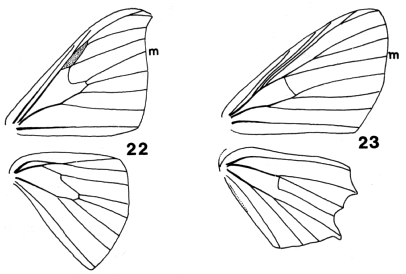
Figures 22-23. Wing venation of Drepanidae (22) and Epiplemidae (23),
showing the areole (stippled) in the former and the position (m) of vein
M2 in both (M1 is anterior to it). 22, Tridrepana
fulvata; 23, Epiplema wilemania.
|
30 |
Forewings triangular, slightly falcate, lacking an areole; build slender;
hindwing M2 roughly midway between M1 and M3 at
cell; Oriental Region .................................................. CYCLIDIIDAE* |
|
- |
Forewings elongate, roughly twice as long as broad, always with an areole;
build robust; hindwings with M2 much closer to M3 than to
M1 at cell ............................................... THYATIRIDAE* |
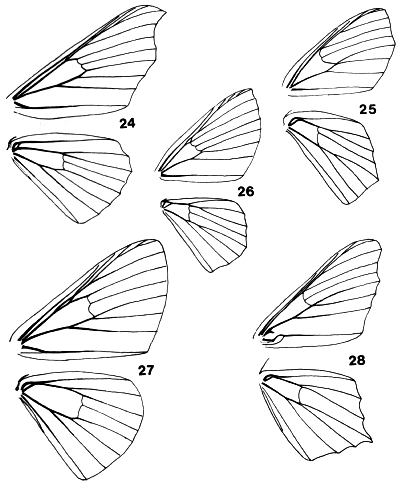
Figures 24-28. Wing venation of Geometridae. 24, Ozola pannosa (Oenochrominae);
25, Lophomachia semialba (Geometrinae); 26, Eois plumbacea (Larentiinae);
27, Problepsis apollinaria (Sterrhinae); 28, Semiothisa emersaria (Ennominae).
Vein M2 of the hindwing meets the cell end crossveins between the
anterior and posterior angles, and is absent in Fig. 28.
|
31 |
Forewing with R5 remote from R2-4 and usually fused
over the basal portion with M1 leading to two systems of branching
veins distal to the cell (Fig. 23); areole absent; male with tympanal organs on
tergum 2,opening posteriorly (Fig. 44) (at base of abdomen in
female) .��.���.. 32 |
|
- |
Forewing with radial veins 2-5 combined in one branching system of veins
distal to the cell (e.g. Fig. 27); forewing areole often present; male and
female with tympanal organs at base of abdomen on first segment Fig. 43
����������. GEOMETRIDAE
�..........................�. 33 |
|
|
|
32 |
Frenulum absent; hindwing usually with single tail or angle; large moths (URANIINAE)
or, if moderate to small, usually white with fine fasciae and striation (MICRONIINAE)
..........................................................................................
URANIIDAE |
| - |
Frenulum present; hindwing often with two tails or angles; small moths,
spanning 20mm or less (except for the Decetia Walker group
which are moderate in size and mostly lack tails)
����������������������������...........
EPIPLEMIDAE |
|
|
| 33 |
M2 of hindwing lacking (Fig. 28) or reduced to a fold
���.............................. ENNOMINAE |
| - |
M2 of hindwing strong
���.�������������������������
34 |
|
|
|
34 |
Sc of hindwing anastomoses strongly with Rs within the cell (Fig. 26),
or (rarely) connected with it within the cell by a cross-vein (R1)
�.������������.�...� LARENTIINAE
|
| - |
Sc free (Fig. 24) or approximating to Rs basally or subbasally (Fig. 27)
but rarely fusing with it . 35 |
|
|
|
35 |
M2 arises very much nearer M1 than M3 on
hindwing (Fig. 25); the majority of species are green; uncus of male genitalia
bifid or, most commonly, associated with two socii ...... GEOMETRINAE |
| - |
M2 on hindwing arises approximately from mid-point between M1 and
M3 (Figs. 22, 27) �.�... 36 |
|
|
|
36 |
Sc on hindwing free though occasionally converging briefly with Rs or
connected by a cross-vein (R1) with cell subbasally (Fig. 24); grey,
or occasionally yellow, brown or white moths with few fasciae; bodies usually
slender and legs long; if robust then moths large ... OENOCHROMINAE
|
| - |
Sc touches Rs over a short distance subbasally but does not fuse with it
(Fig. 27); moths usually pink or pale fawn, sometimes yellowish or white, the
wings often multifasciate
... STERRHINAE
|
* Minet (1983) has subordinated these two families to the Drepanidae. |
|
|
|
37 |
Large moths (wingspan over 40mm), or, if small, forewings broad,triangular;
haustellum often absent or vestigial; frenulum also often absent; ocelli and
chaetosemata (Fig. 8) absent (if chaetosemata present then hindwing
conspicuously tailed or antennae filiform, expanding towards apex, combined with
orange and brown pattern and butterfly-like build) �������.........
38 |
|
- |
Small to medium-sized moths (wingspan usually under 30mm); wings, with a few
exceptions, narrow, the forewing twice as long as broad or more, square-ended or
lenticular in many instances; haustellum and frenulum usually present; ocelli
and chaetosemata sometimes present
.......................................................................................
the remaining microlepidoptera |
|
|
|
38 |
Chaetosemata present
��������������������������.........
39 |
|
- |
Chaetosemata absent
����������������������������...
40 |
|
|
|
39 |
Wingspan greater than 40mm; hindwing tailed, resembling species of Uraniidae;
New World
�......................................����������������....
SEMATURIDAE
(part) |
|
- |
Wingspan less than 40mm; hindwing rounded or, at most, angled; build and field
behaviour butterfly-like; pattern of wings orange on dark brown; Indo-Australian
tropics .CALLIDULIDAE
|
|
|
| 40 |
Forewing (Fig. 29) veins R4 and R5 arising from a
common stalk at the cell, separated from that giving rise to R2 and R3
; M1 is usually only connate at the base of R4+5
New World ���������������������
MALLONOIDEA:
MIMALLONIDAE |
|
- |
Forewing veins with different configuration. BOMBYCOIDEA ��.���������.
41 |
|
|
| 41 |
M2 arising nearer M3 than M1 in both fore-
and hindwings, such that the cubitus (posterior vein of cell) appears quadrifid
or four-branched (Fig.
31) .�������������..���.� 42 |
|
- |
M2 arising nearer M1 than M3 in at least one
pair of wings such that the cubitus appears trifid or three-branched (Fig. 30)
�����������������������..���....
46 |
|
|
|
42 |
M1 on forewing usually stalked with R5 radial veins
usually in two branching systems (Fig. 31); hindwing veins Sc and Rs share a
short common stalk or anastomose, separating from the cell near the base (Fig.
31) ������������........��.......................
LASIOCAMPIDAE |
| - |
M1 on forewing not stalked with R5 but usually
connate at base; fore- wing radial veins in a single branching system; hindwing
vein Rs separates from cell at its anterior distal angle and is not associated
with Sc when not forming part of cell ���..�����..�����................ 43 |
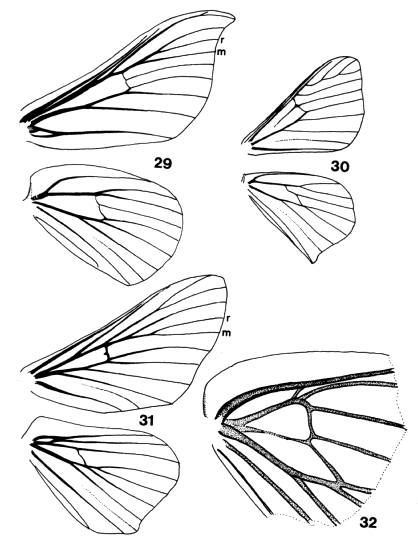
Figures 29-32. Wing venation of Mimallonidae (29), Bombycidae (30),
Lasiocampidae (31), and Brahinaeidae (part of hindwing only) (32). Veins R5
(r) and M1 (m) are indicated in 29 and 31. 29, Cicinnus
despecta; 30, Ocinara albiceps; 31, Streblote acaciae; 32, Brahmaea
hearseyi.
|
43 |
Hindwing vein Sc adjacent to, or fused with cell at base only, with no
cross-vein ���...�� 44 |
|
- |
Hindwing vein Sc linked to cell by cross-vein (R1)
...�������.��������..... 45 |
|
|
|
44 |
Forewing with a large areole beyond the anterior angle of the cell;
Australasia ... ANTHELIDAE
|
| - |
Forewing without an areole
..........��...���������.��
EUPTEROTIDAE
(part) |
|
|
|
45 |
Antennae stout, often hooked at the tip, rarely distinctly bipectinate;
haustellum often very long though sometimes weak; frenulum present
�.�����....����...���
SPHINGIDAE |
|
- |
Antennae distinctly bipectinate, not hooked apically; haustellum weak;
frenulum absent; Palaearctic ������.�������.............................����������
ENDROMIDAE
|
|
|
| 46 |
Frenulum strongly present (though reduced in female EUPTEROTIDAE)
��..�����. 47 |
|
- |
Frenulum very weak or absent
�����.��������������.������49 |
|
|
|
47 |
Haustellum strong; hindwing vein Sc connected to cell by cross-vein (R1);
Australia ���������������������.�����.���.�
CARTHAEIDAE |
|
- |
Haustellum reduced or absent; hingwing Sc mostly not connected to cell by
cross-vein �.�.� 48 |
|
|
| 48 |
Medium-sized species; forewings usually falcate or forewing margin angled;
markings on hindwing usually distinctly more intense along the dorsum; New World
������. APATELODIDAE
|
| - |
Medium to very large species; forewings rarely falcate, margins mostly
rounded; hindwing markings not more intense along dorsum; wing scaling coarse;
predominantly Old World .............................................................................................. EUPTEROTIDAE (part) |
|
|
|
49 |
Hindwing finely folded along dorsum (Fig. 30) which is straight to concave
with dark markings and fasciae more intense; Old World
��������������................ BOMBYCIDAE |
|
- |
Hindwing not folded or with markings conspicuously darker
��.����...���......�..... 50 |
|
|
|
50 |
Hindwing vein Sc well separate from cell and not linked to it by a cross-vein
except almost basally
�����������������������������............................�
51 |
|
- |
Hindwing vein Sc and Rs in cell closely approximate, fused or linked by R1
as a cross-vein �... 52 |
|
|
|
51 |
Haustellum fairly strong; male antennae bipectinate; New
World ��.���� OXYTENIDAE |
|
- |
Haustellum vestigial or absent; often very large moths with hyaline patches or
ocelli at the forewing or hindwing discal area; male antennae often
quadripectinate ��..� SATURNIIDAE
|
|
|
| 52 |
Hindwing Sc linked to cell by cross-vein; New World
���....���� CERCOPHANIDAE |
|
- |
Hindwing otherwise
��������������....��������������
53 |
|
|
|
53 |
Sc of hindwing approximate to distal half of cell and to Rs beyond before
diverging (Fig. 32); hindwing cell short, broad, with medial veins weakly
present within it; distinctive rippled pattern between postmedial and
submarginal of both wings �....�����.��� BRAHMAEIDAE
|
| - |
Sc and Rs fused over much of length, separating well beyond end of cell;
space lb of forewing often with prominent median line of contrasting colour
���������.� LEMONIIDAE
|
|
|
| 54 |
Tympanum present on thorax or abdomen
��������������......�����. 55 |
|
- |
Tympanum absent
���������������������.��.... microlepidoptera |
|
|
|
55 |
Tympanum thoracic
���������..���������.��.� LYMANTRIIDAE
|
| -
|
Tympanum at base of abdomen
��������.��������..� GEOMETRIDAE
|
|










